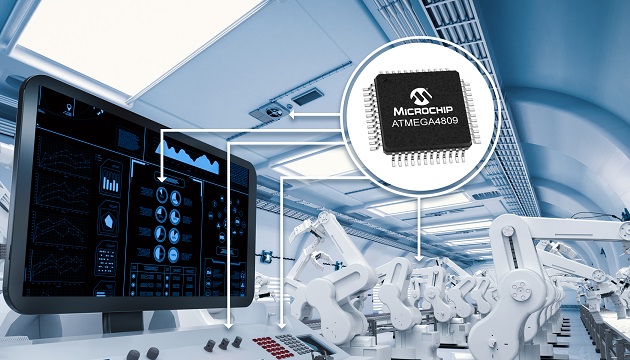Whether it’s used as an initial introduction into embedded development, the main controller of a connected application or as an attached component to offload tasks from a larger system, the role of the 8-bit microcontroller (MCU) continues to expand. While inherently simple to understand and implement, additional hardware and software tools, such as Core Independent Peripherals (CIPs), Intelligent Analog and MPLAB Code Configurator, enable greater processing power while decreasing the amount of code, power consumption and design effort needed to get to market quickly. Microchip Technology Inc. has introduced two new microcontroller families designed with customer innovation in mind.
The new PIC16F18446 family of microcontrollers are ideal components for use in sensor nodes. Designed with flexibility in mind, the PIC16F18446 and its integrated Analog-to-Digital Converter with Computation (ADC2) runs from 1.8V to 5V, providing compatibility with a majority of both analog output sensors and digital sensors. The 12-bit ADC2 does its filtering autonomously, providing more accurate analog sensor readings and ultimately higher-quality end-user data. Because the ADC2 has the ability to wake the core only when needed, instead of on a pre-determined schedule, the power consumption of the system is lowered, making this MCU ideal for battery-powered applications. This power-saving capability also enables sensor nodes to run on small batteries, decreasing end-user maintenance costs and the overall design footprint.
The introduction of the ATmega4809 brings a new series of megaAVR microcontrollers that were designed to create highly-responsive command and control applications. The processing power of the integrated high-speed Analog-to-Digital Converter (ADC) enables faster conversion of analog signals resulting in deterministic system responses. As the first megaAVR device to include Core Independent Peripherals (CIPs), the ATmega4809 can execute tasks in hardware instead of through software. This decreases the amount of code and can tremendously reduce software efforts for faster time to market. For example, the Configurable Custom Logic (CCL) peripheral can connect the ADC to a customised combination of external triggers through hardware, without interrupting the core, which improves response time while reducing power consumption. The ATmega4809 can also be added to a system to offload functions from more complex microprocessor (MPU)-based designs. By using CIPs to execute command and control tasks in the MCU instead of in the MPU, the risk of delayed responses is decreased, resulting in a better end-user experience.
The ATmega4809 has been selected to be the onboard microcontroller of a next-generation Arduino board. The addition of the ATmega4809 to this board, allows developers to spend less time coding and more time creating. The hardware-based CIPs enable the creation of designs which are more efficient while making the transition from project to production-ready easier than ever before.
“The adoption of the ATmega4809 in the next-generation Arduino board strengthens our partnership and brings the benefits of CIPs and Intelligent Analog to the Arduino platform,” said Steve Drehobl, vice president of Microchip’s 8-bit MCU business unit.
Development Tools
The new PIC16F18446 microcontrollers are compatible with MPLAB PICkit 4 (PG164140), Microchip’s latest in-circuit tool for low-cost programming and debugging. The Curiosity development board (DM164137), a feature-rich rapid prototyping board, can also be used to start development with these MCUs. Both development tools are supported by the MPLAB X Integrated Development Environment (IDE) and the cloud-based MPLAB Xpress IDE. Additionally, MPLAB Code Configurator (MCC), a free software plug-in, provides a graphical interface to configure peripherals and functions for any application. Designers wanting to begin development immediately can download rapid-start code examples and order a complimentary MPLAB Xpress PIC16F18446 development board, available for a limited time.
Rapid prototyping with the ATmega4809 is supported by the ATmega4809 Xplained Pro (ATmega4809-XPRO) evaluation kit. The USB-powered kit features touch buttons, LEDs and extension headers for quick setup as well as an on-board programmer/debugger that seamlessly integrates with the Atmel Studio 7 Integrated Development Environment (IDE) and Atmel START, a free online tool to configure peripherals and software that accelerates development.
The Curiosity development board and the ATmega4809 Xplained Pro evaluation kit have a mikroBUS-compatible socket, allowing for the easy additions of sensors, actuators or communications interfaces from Mikroelektronika’s extensive library of click boards.
Availability
The PIC16F18446 and ATmega4809 devices are available today in a variety of memory sizes, pin counts and package options in volume production quantities. The MPLAB PICkit 4 programmer/debugger, the Curiosity development board and the ATmega4809 Xplained Pro evaluation kit are also available








